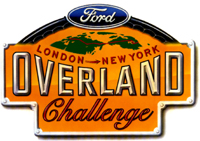Overland Challenge - Overview
Created | Updated Sep 4, 2002
- Overland Challenge - Team
- Overland Challenge - Map
- Overland Challenge - Itinerary
- Diary - Richard Creasey
- Photos - Richard Blanshard
- Poems - Jeni Ballagh
- Video - Kees t'Hooft
- Ford Mondeo - Specifications
- Ford Maverick - Specifications

As we approach the first decade of the first century of the third millennium, it's clear that the world as we know it will only survive if we work together, think of ourselves as neighbours, and fight as one team for what we believe in.
- Richard Creasey
Getting Started
In December 1993, Richard Creasey assembled an international team, endorsed by the United Nations as part of its 50th anniversary celebrations, which would attempt to be the first ever to drive from London to New York - a journey that was considered at the time to be absurd and quite impossible by a whole bunch of expert commentators. The Ford London to New York Overland Challenge expedition would involve three first ever 'drives'. The first would be through the Channel Tunnel as part of a journey - which was then not completed - the second a hair-raising dash across the vast and treacherous Russian continent in temperatures falling as low as -59°C - the third crossing the 56 mile wide Bering Straits - provided the water froze over that winter. And if the team achieved these there was a snowmobile marathon across Alaska before the snow thawed, and a four day non-stop drive to the United Nations headquarters in New York.
Creasey Makes His Pitch
It takes a while to get used to the blank stare of disbelief on the face of those hearing my project proposal for the first time.
My first pitch was made in October 1992, at 30,000 feet on a British Midland flight from Nice to London just after the Captain announced we were flying over the Channel Tunnel, then being constructed... which meant in a year or two we could actually drive to France. I had a couple of minutes of hallucinating thought and then turned to Charles Brandt, the Managing Director of Tiger Television Productions, and his colleague Jeremy Bradshaw, an award-winning natural history film maker. The three of us were on our way back from MIPCOM, the Cannes international television fair. 'I've just had an idea', I said.
'Picture a map of the world. Home in on the UK. Channel Tunnel opening in December 1993. That means you can drive from London to Paris. Paris to Berlin is easy, as is Berlin to Moscow - I did it with my two boys last summer. There are roads from Moscow to Lake Baykal so that's easy too, and there are roads, not very good ones, from Irkutsk to Magadan at the top end of the Sea of Okhotsk. Now, there must be a way of getting from there to the Bering Straits. I know two ton sleighs have been taken across the Straits laden with goodies by the Chukchi. Once you're in Alaska it's relatively simple to get to Canada. A quick tumble and you're in the USA at the end of the first ever overland London to New York drive.'
'With you driving ?' asked Charles Brandt, incredulously.
The Dream Becomes Reality
However, Richard Creasey was persistent - he still wanted to lead the challenge himself, and not have celebrities do it for him. Remember, this mad idea of driving from London to New York, if it was to really take off, needed a lot of funding, running in to millions of pounds. And this kind of money would most likely be generated if the challenge involved high-profile, media-friendly personalities. Nevertheless, two pitches later, Creasey was able to formalise his ideas on to paper. Billed as 'The Big Race' Creasey's original formal pitch had the idea that two teams on opposite sides of the ocean - one in New York, one in London - would head off at the same time and race each other to swap places, driving all the way. The race idea was eventually dropped but the main idea stayed the same, and the philosophy of international co-operation behind it grew stronger and stronger.
And gradually people bought the idea, for instance ITV wanted to commission the making of a major eight-part TV series covering the entire trip, the United Nations and two of its agencies the United Nations Environment Programme (UNEP) and the United Nations Educational, Scientific and Cultural Organization (UNESCO) had formally endorsed the challenge. ‘The greatest round the world challenge of modern times' was now a reality. Soon major sponsorship and funding, especially that from Ford, would start to come in, and Richard Creasey and his international team would soon be preparing themselves for the drive of their lives.

